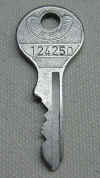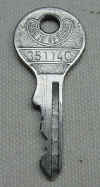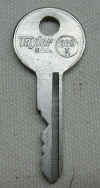BMW motorcycle fork and tank lock keys by Neiman |
|
You are reading this because you already have a key problem. Too bad, because if you had read this a while back, you wouldn't be here now. This is in two parts: the nature of people and how we dealt with it. A BMW motorcycle came with two (three after 73) factory keys. They are steel and made by Neiman. It is hard to get real blanks on this side of the pond. Even if you had them, most locksmiths won't cut steel keys. Taylor makes, or used to make, blanks that work for your BMW. They are soft and locksmiths will cut them. The soft American key blanks bend easily in the hands of someone that doesn't know how to use the lock. The steel keys are stronger and I prefer them. If you want a duplicate key blank for your BMW motorcycle try to get a Neiman blank and then find a locksmith that will cut it, or do it yourself with a file. It only takes a couple of minutes. It is possible that someone could see your key code on your original key and easily make a key from that number. Since BMWs are rarely stolen, that is a very small risk. A locksmith can make a key for your motorcycle if you take in the part with the lock, maybe the whole bike. The nature of people, or "How can they be so stupid"?We were often receiving calls from owners asking if we could use our secret "code" and get a key made for their BMW. We had to disappoint them, as BMW didn't have one. It was very expensive to replace all of the locks with a matching set. We had to do something about this demand. On delivery of the new bike, we emphasized the importance of the keys. We not only showed how to lock the fork, but made them do it a few times in front of us. We held the forks so that they couldn't snap it off, by turning the fork, right in front of us. Don't ask me how I learned that one. Obviously we couldn't trust owners with keys. As soon as a new bike came in from BMW, we made two copies of the originals. We kept one original and gave the owner the other original and the two copies. Don't ever use an original on the bike. It is only for making copies and belongs with your birth certificate and other valuables. Use the copies for everything. When you lose both of the copies and then start using the original, because you don't have time to copy it, and then lose it too, we can make you a duplicate key for your BMW motorcycle from our shop original. You are asking "How can anyone be so stupid as to get into that situation?" I don't know the answer, but it happened often. At least now we had a way out, actually two. We had written the key code in the front of the owners manual , but the owner often had lost that too. We kept it recorded in our pre delivery work order. We were also able to make a copy, by hand, using the code. Or, we could make a copy from the single original. It was faster to hand file a copy than to drive to the locksmith and just as accurate. We used a triangle file. After we had gone through all of this routine about keys, can you imagine calling us to get a copy? You should have seen them "crawl" into the shop. We had so much fun with our abuse and did they pay, not only in dollars. This program worked, as we were able to reduce the "lost key" thing by about 1/2. Pain is a good teacher. If you are lucky enough to have an original steel key, by Neiman, write the number down in two places. One of them should be with the bike. The inside page of the owners manual has a place for it. Who knows, maybe you will be on the road and need a key cut. Make at least two copies and never again use the original in the bike. Keep it in a safe place, that means where you will never again find it, but your spouse can. If you have a key, but it doesn't have the key code numbers, go to the bottom of this page to learn how to "decode" a key. This information is from locksmith John Blankenship, thanks.I checked out those blanks and came up with the following. Refer to the attached photo of American blanks. Ilco VO6 (on left): It is designed for Volvo automobiles using 6 tumblers and BMW motorcycles use 5 tumblers. That is why it is longer from the tip to the shoulder. It fits the BMW keyway and will probably work but you risk the tip of the key contacting the end of the keyway and stopping the key before the shoulder contacts the shoulder stop in the lock. Taylor B69K (2nd from left): It will work, but has been discontinued since Ilco bought Taylor. Ilco SR61N (2nd from right): It is the Ilco version of the B69K and is still being produced. Ilco Y61 (on right): This is made for 1994 and earlier BMW motorcycles. The main difference between the SR61N and the Y61 is the shoulder stop. The shoulder stop on the SR61N sticks out a lot farther that the shoulder stop on theY61. The best I have been able to determine is that the Y61 is for 1986 to 1994 models and the pre-86 models may use just one or maybe both of them. I have not had enough experience on older BMW motorcycles to know for sure. Thanks for the info and I hope this helps. FYI, I cut BMW motorcycle keys by code. In fact, I cut almost all motorcycle keys by code. More info is at my web site; http://www.motorcyclekeys.com/keys.html John Blankenship More about BMW motorcycle key blanksAll /2 (55-69) used the same key blank by Neiman. The fork lock and small tank tool box used one key for both. They were keyed alike. BMW always had the locks keyed alike. If your bike needs two keys, then one or both have been changed for sure. You can still get a lockset. The original BMW part number is 32 32 9 016 105, but maybe only 51 25 1 233 554 is now available. The /2 BMW small tank tool box.The /2 BMW 4.5 gal. (small) tank had a tool box on the left side of the tank. This scheme was first introduced on the R25/3. The lock is attached by three soft rivets. Gently remove the rubber knee pad to expose the 3 lock rivets on the outside. This shows the lock and three rivets from the inside. You can see the hammer marks made when peening the rivet into place. The factory had a real riveter and the surface is an even crown. These hammer marks show that the lock has been replaced. It could have been the original one that has been removed and reinstalled. Usually it means that someone didn't have a key and replaced the old lock with one that had a key. The rivets can be drilled out easily to remove a tool box lid that has no key. Be careful with the drilling. You certainly don't want to damage any items stored in the tool box when the drill bit goes through. With the tool box now open, you need to remove the lid from the tank. It is attached by the two hinges. The two hinge pins are a soft material. One end has a head like a nail. The other end has a split cut into it. That is so that once it is installed, the split can be spread apart to help it stay in place and not "work its way out" of the hinge. Make sure that you have the rubber gasket to keep water out. This shows the front of a tool box lid with the lock removed. Photo by Mark, thanks. This shows the inside of the tool box with the lock removed. The gasket is missing from the channel around the outside edge of the lid. Photo by Mark, thanks. This is a lock that has been drilled out for removal. Don't drill out the center area as shown as that is the tumblers. Only drill out the rivets. Photo by Mark, thanks. BMW /2 small tank tool box lid hinge pin. The pin is about 1 3/8" long with a split of about 3/16". Each pin can be slid out by using a small screwdriver under the head of the pin. There is little room for a punch. Since the parts are all black, it is hard to photograph. The large white spot at the left side is one of the rivets. Just above and to the right is a tiny brown spot. That is the head of the left hinge pin. It is "out" of the hinge about 3/16" or so. The right one has a small space and can barely be seen. One must take advantage of this space. This one shows what one can do to remove the pin. Use a small screwdriver to stick into the small space and tap sideways on the screwdriver with a hammer as shown. You may have to use your imagination for this one. A "movie" would be better. The pins usually come out easily. It may help to oil the pin first. BMW Locking gas capsThe main thing is to understand that locking gas caps caused 10 times more trouble than vandalism ever did. The locks jammed and owners would lose keys. I only saw a couple of possible cases of vandalism in all of my years of BMW. We averaged about two owners a month coming in with locking gas cap trouble. Usually it was "I am on reserve and left my key at home" so we would use some fuel line to "backfill" the tank. Next was lost keys and lastly jammed up locks. I should have offered locking gas caps to everyone for free. The resulting labor would have paid me back many times over. For the /2, several aftermarket caps were available. None used the same key blank as the lockset. One very common one was larger and chrome. When it was locked the cap would turn freely. The key was a very simple one that didn't use tumblers. It was very cheap and often failed. The easy way to remove it is to just drill a hole down into the cap and then into the next surface below. With the drill in place, or a nail, rotate and remove. The nail simply locks the freely spinning cap with the part that goes into the tank. The key for a locking gas cap on a /2, or /5, never matched the other keys. That is because the locking gas cap was only available as an accessory. The /5 used the same key blank as the /2. The /6 used three different styles of key, but all were keyed alike. The /5 BMW locking gas capThe cap used the same key blank as the lockset. It always seemed to us that there was some way to get the cap lock to be "keyed alike" and use the same keys as the other locks. We were told by Butler and Smith that there was "no way" to do it. Recent email encouraging Ben McCafferty to explore getting them matched resulted in this info. Took the tank to a locksmith here in Boulder, and he was able to re-pin the lock in about five minutes. Instead of removing the lock cylinder, he removed the pivot pin for the lock/button, and the whole squarish piece came out and he accessed the tumblers that way. The Neiman key now fits all three locks on the bike. The cap I have is chrome, flips to the rear, and the keyhole is under a small chrome flap. When locking it, you must push the lock/button for the cap slightly forward, and the key turns about 60 degrees to the locked position. If anyone would like pictures of my cap (to compare and see whether you have the same one), I'd be happy to send one along. The /6 BMW keysIn 1974, BMW came out with the /6 model. The standard flat key was lengthened and two additional styles were introduced. One of the large complaints was the key getting broken off in the fork lock. BMW added a folding key to allow the owner to leave it in the lock and turn the forks without breaking it off. It didn't help anything at all. The owner that was too distracted (read stupid) to learn to not break it off, was also unable to learn to use the key made just for that purpose. The second addition is the "knob" key, shown below. This is the /6 folding key in the "useful" position. This is the /6 key in the folded position where the fork won't hit it. The /7 BMW keysThe gray plastic key was changed for the /7 models. The gray plastic key didn't look very good in the ignition position. I am not sure exactly when the change was made. This folding part is black plastic and of higher quality. When folded, the key is in the middle of the plastic, not off to one side as with the gray /6 key. This is the /7 folding key in the flat position. The front side with the logo This is the key in the folded position. In this position the fork won't hit it. This one also works and looks good in the ignition switch. This is the other "new key" for the /6 and /7. We called it the knob key. Locksmiths were unable to copy it easily, so we just filed them. This key was intended to go into the ignition switch on the side of the headlight. This is the ignition lock. Before 1974, all headlights were mounted with a bolt through the headlight ear on each side. The left bolt was replaced with an electrical switch for the ignition and lights. In 1974 only, the lock had 5 positions and afterwards, only 3 positions. This is the BMW knob key in the switch. It is fairly well camouflaged. The key codes, here is what those numbers mean.The deepest cut is denoted by a 1. The last item is a O (letter) which is the series. Starting at the top and going down, it makes sense. The 1 is a deep cut, almost to the slot. The next cut, a 2, isn't as deep. Next is only a very tiny bite out of the metal and that is a 4. Then we have another cut equal to the second cut, another 2. Next is no cut, which is a 5. Thanks to John Blankenship for his corrections. Follow the same rules as before and carefully examine the cuts. You have studied long enough, this is a test. If you don't pass, the BMW god will revoke your right of ownership of any and all BMW's, forever. Look at it long and hard. This key isn't cut very well. This is an open book test. If you pass this test, then you are able to "decode" your key and have the number. The answer can be found at the bottom of the page on locks. To learn all about how to re-key the seat lock, go to http://www.airheads.org/index.php?Technical%20Tips+Rekeying%20a%20Seatlock For better pics on the key codes, go to http://www.stephenbottcher.net/BMW/keys.htm For another perspective, go to http://users.pandora.be/tups/keys.htm For more information on the black plastic keys and the headlight switch used on the /2 and /5, click here. |
|
This page was last edited:
04/10/2006 - copyright
Duane Ausherman |






